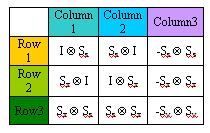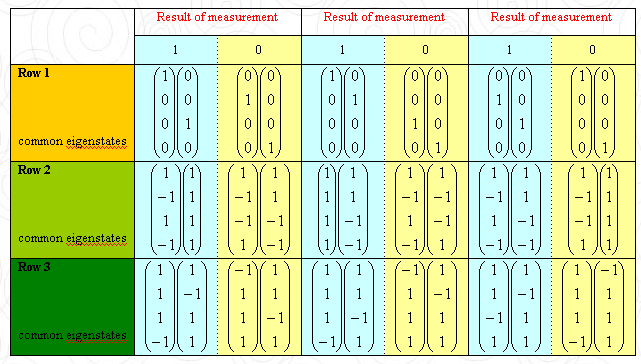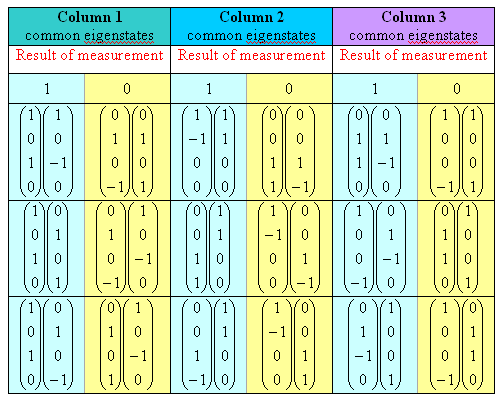

Mathematical details
In the tables below, we list the common eigenstates for the observables in each row. The observables in each row can be measured together. If the result of a measurement is a 1, then the system is left in a combination of the eigenstates in the left (blue) half of the cell, and if the result of a measurement is a 0, then the system is left in a combination of the eigenstates in the right (yellow) half of the cell, independent of how the initial state was prepared.


Assume we measure the observables in row 1 and obtain the
results 1, 1, and 0 for the operators I *
Sz, Sz * I, and -Sz
* Sz respectively. The
measurement of I * Sz tells
us that the system is in a combination of the eigenstates
![]() and
and
![]() , the measurement of Sz * I
then tells us that it is in the state
, the measurement of Sz * I
then tells us that it is in the state
![]() ,
and that fixes the outcome of the measurement of -Sz
* Sz.
,
and that fixes the outcome of the measurement of -Sz
* Sz.
Now let us list the common eigenstates for the observables in each column. The observables in each column can be measured together. If the result of a measurement is a 1, then the system is left in a combination of the eigenstates in the left (blue) half of the cell, and if the result of a measurement is a 0, then the system is left in a combination of the eigenstates in the right (yellow) half of the cell, independent of how the initial state was prepared.


Assume we measure the observables in column 2,
after having measured the observables in row 1 and having obtained the results
1, 1, and 0 for the operators I * Sz,
Sz * I, and -Sz
* Sz respectively. We know
that the system is in the state
![]() ,
which is an eigenstate of Sz *
I. This state is not listed explicitly in cell (1, 2), the top cell of column 2
in the above table, but it can be written in terms of the two state with
eigenvalue 1 which are listed there, namely
,
which is an eigenstate of Sz *
I. This state is not listed explicitly in cell (1, 2), the top cell of column 2
in the above table, but it can be written in terms of the two state with
eigenvalue 1 which are listed there, namely
![]() =
= ![]() +
+
![]() .
It cannot be written as a linear combination of the states with eigenvalue 0.
So measuring row 1 and then measuring column 2 guaranties that we get the same
result for cell (1, 2), the intersection of the row and the column. This holds
for any combination of a row (i) and a column (j). Similarly we can show that
if we first measure column 2 and then row 1, we also get the same result for
cell (1, 2), the intersection of the row and the column. It does not matter if
the row or the column is measured first.
.
It cannot be written as a linear combination of the states with eigenvalue 0.
So measuring row 1 and then measuring column 2 guaranties that we get the same
result for cell (1, 2), the intersection of the row and the column. This holds
for any combination of a row (i) and a column (j). Similarly we can show that
if we first measure column 2 and then row 1, we also get the same result for
cell (1, 2), the intersection of the row and the column. It does not matter if
the row or the column is measured first.